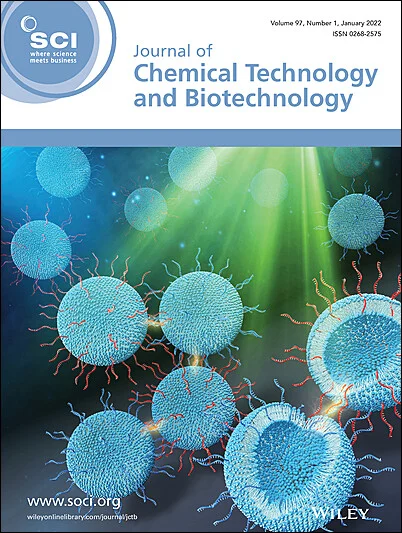Fu Yin, Fan Qu, Han Yang, Fei Wang, Yuxue Wei, Song Sun, Qiang Chang, Chenghua Zhang
求助PDF
{"title":"镍羰基化制四羰基镍的动力学研究:温度、压力和粒径的影响","authors":"Fu Yin, Fan Qu, Han Yang, Fei Wang, Yuxue Wei, Song Sun, Qiang Chang, Chenghua Zhang","doi":"10.1002/jctb.7920","DOIUrl":null,"url":null,"abstract":"<div>\n \n \n <section>\n \n <h3> Background</h3>\n \n <p>The nickel carbonylation reaction is of great significance for nickel extraction and the application of nickel-based materials. Previous studies have mostly been conducted on nickel without load. However, the ores used in industrial nickel extraction contain various oxides, and the size of nickel can affect the reaction. Ni/Al<sub>2</sub>O<sub>3</sub> catalysts are common, and it is appropriate to study the influence of various parameters on the formation kinetics of Ni(CO)<sub>4</sub> on them.</p>\n </section>\n \n <section>\n \n <h3> Results</h3>\n \n <p>Temperature, pressure and particle size have different effects on the carbonylation reaction of Ni in Ni/Al<sub>2</sub>O<sub>3</sub>. Specifically, the reaction rate is the fastest when the temperature is 80°C. Increasing pressure can rapidly accelerate the carbonylation reaction process. When the particle size is within 8.1–9.1 nm, the carbonylation reaction rate reaches the highest.</p>\n </section>\n \n <section>\n \n <h3> Conclusion</h3>\n \n <p>The study revealed that the carbonylation rate of Ni is accelerated significantly with the increase of temperature and pressure. Through the in-depth analysis of the first derivative of Ni conversion of the model sample, it is found that the reaction process of Ni with CO can be clearly divided into two stages: the first stage occurs quickly due to a large number of highly active Ni atoms contacting with CO; the second stage is accompanied by the increase of internal defects, cracks and grooves in Ni particles, and these structural changes make more Ni sites exposed. In addition, small size of Ni exhibited higher initial activity than large size of Ni, but could have a lower reaction degree after sufficient reaction time. © 2025 Society of Chemical Industry (SCI).</p>\n </section>\n </div>","PeriodicalId":15335,"journal":{"name":"Journal of chemical technology and biotechnology","volume":"100 9","pages":"1838-1847"},"PeriodicalIF":2.4000,"publicationDate":"2025-06-24","publicationTypes":"Journal Article","fieldsOfStudy":null,"isOpenAccess":false,"openAccessPdf":"","citationCount":"0","resultStr":"{\"title\":\"The kinetic study of nickel carbonylation to nickel tetracarbonyl: effect of temperature, pressure and size\",\"authors\":\"Fu Yin, Fan Qu, Han Yang, Fei Wang, Yuxue Wei, Song Sun, Qiang Chang, Chenghua Zhang\",\"doi\":\"10.1002/jctb.7920\",\"DOIUrl\":null,\"url\":null,\"abstract\":\"<div>\\n \\n \\n <section>\\n \\n <h3> Background</h3>\\n \\n <p>The nickel carbonylation reaction is of great significance for nickel extraction and the application of nickel-based materials. Previous studies have mostly been conducted on nickel without load. However, the ores used in industrial nickel extraction contain various oxides, and the size of nickel can affect the reaction. Ni/Al<sub>2</sub>O<sub>3</sub> catalysts are common, and it is appropriate to study the influence of various parameters on the formation kinetics of Ni(CO)<sub>4</sub> on them.</p>\\n </section>\\n \\n <section>\\n \\n <h3> Results</h3>\\n \\n <p>Temperature, pressure and particle size have different effects on the carbonylation reaction of Ni in Ni/Al<sub>2</sub>O<sub>3</sub>. Specifically, the reaction rate is the fastest when the temperature is 80°C. Increasing pressure can rapidly accelerate the carbonylation reaction process. When the particle size is within 8.1–9.1 nm, the carbonylation reaction rate reaches the highest.</p>\\n </section>\\n \\n <section>\\n \\n <h3> Conclusion</h3>\\n \\n <p>The study revealed that the carbonylation rate of Ni is accelerated significantly with the increase of temperature and pressure. Through the in-depth analysis of the first derivative of Ni conversion of the model sample, it is found that the reaction process of Ni with CO can be clearly divided into two stages: the first stage occurs quickly due to a large number of highly active Ni atoms contacting with CO; the second stage is accompanied by the increase of internal defects, cracks and grooves in Ni particles, and these structural changes make more Ni sites exposed. In addition, small size of Ni exhibited higher initial activity than large size of Ni, but could have a lower reaction degree after sufficient reaction time. © 2025 Society of Chemical Industry (SCI).</p>\\n </section>\\n </div>\",\"PeriodicalId\":15335,\"journal\":{\"name\":\"Journal of chemical technology and biotechnology\",\"volume\":\"100 9\",\"pages\":\"1838-1847\"},\"PeriodicalIF\":2.4000,\"publicationDate\":\"2025-06-24\",\"publicationTypes\":\"Journal Article\",\"fieldsOfStudy\":null,\"isOpenAccess\":false,\"openAccessPdf\":\"\",\"citationCount\":\"0\",\"resultStr\":null,\"platform\":\"Semanticscholar\",\"paperid\":null,\"PeriodicalName\":\"Journal of chemical technology and biotechnology\",\"FirstCategoryId\":\"5\",\"ListUrlMain\":\"https://scijournals.onlinelibrary.wiley.com/doi/10.1002/jctb.7920\",\"RegionNum\":4,\"RegionCategory\":\"生物学\",\"ArticlePicture\":[],\"TitleCN\":null,\"AbstractTextCN\":null,\"PMCID\":null,\"EPubDate\":\"\",\"PubModel\":\"\",\"JCR\":\"Q3\",\"JCRName\":\"BIOTECHNOLOGY & APPLIED MICROBIOLOGY\",\"Score\":null,\"Total\":0}","platform":"Semanticscholar","paperid":null,"PeriodicalName":"Journal of chemical technology and biotechnology","FirstCategoryId":"5","ListUrlMain":"https://scijournals.onlinelibrary.wiley.com/doi/10.1002/jctb.7920","RegionNum":4,"RegionCategory":"生物学","ArticlePicture":[],"TitleCN":null,"AbstractTextCN":null,"PMCID":null,"EPubDate":"","PubModel":"","JCR":"Q3","JCRName":"BIOTECHNOLOGY & APPLIED MICROBIOLOGY","Score":null,"Total":0}
引用次数: 0
引用
批量引用



 求助内容:
求助内容: 应助结果提醒方式:
应助结果提醒方式:


